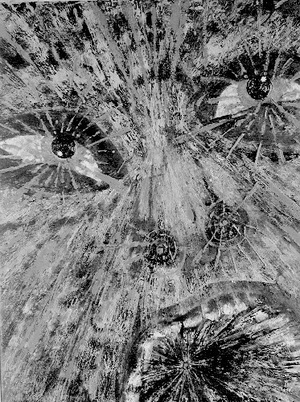My mother told me one day that fear was useless in her life. Her statements confront what many of us believe peace should be—obedience, disciplining ourselves to be docile, good citizens, with fear not far behind our actions. Fear of not being seen as an American, fear of being interned again at the drop of a hat, fear of doing ‘wrong’ in the eyes of the US government or Japan—fear has been a constant presence for many Japanese Americans. My mother has always wanted a life which resisted these norms. For her, docility meant conformity to norms of privilege and power—power that continues to marginalize, oppress, exclude.
For my mother, the world makes sense only when one makes sense up. In Albuquerque, New Mexico in 1977, my mother, Kiyoko, began screaming and crying out while she was bathing one night. Neighbors had to rush her to the hospital where we were told she had a breakdown and needed rest. Later my mother told me she had relived the horrible day in 1940 when her mother was brutally killed by Japanese soldiers in their house in Osaka, Japan. Kiyoko, then three years old, was forced to watch. Neighbors had reported to the authorities that her mother was Chinese.
Kiyoko was born in Soochow, China in 1937. Her mother, daughter of an Austrian diplomat father and Chinese-Thai mother, defied her parents’ wishes to marry Kiyoko’s father, a Japanese national. The family had moved to Japan from Manchuria a year before the outbreak of World War II. Hoping to escape death from Chinese assassins who wanted to take back control of their country from the Japanese, Kiyoko’s mother was targeted by neighbors as a spy against the Japanese nation.
In Japan, school was a torment. Kiyoko was not considered Japanese; she was “impure.” Girls and boys sometimes beat her and taunted her. She joined gangs for protection against the violence of the normal ‘good’ Japanese. The legitimacy of her older brother and father’s condescending behavior towards her contributed to her feelings of inferiority and rebellion. But gangs also gave her a bit of power in a world that denied her. She pushed herself in studies and became the only 14-year old girl to be accepted into one of Japan’s most prestigious medical schools, where she was ostracized by older students.
Japan’s intense nationalism in the 1940s relegated my mother to someone who did not belong. She was part Chinese, part white. She was an enemy. But Japan would become a scene of fiery devastation as American B-29 bombers began campaigns over her city, Osaka. After the US dropped atomic bombs on Hiroshima and Nagasaki in 1945, Kiyoko, with her family, went to Hiroshima to search for her older sister. My mother's memories of the city after the atomic bomb are a charred, orange-skied, smoky surrealist painting. Young and old, women, men, children ghost-walked through the streets in a daze. Hanging skin with white meat showing underneath, eyeballs protruding without eyelids and their skin burned by radiation. Searching for food. My mother’s half-sister died in one flash—charred, disintegrated, gone. Memories of US bombing and the death of her closest loved ones remain today. My mother once reflected: “I used to feel like I was a snowflake falling in valleys of fire. Disintegrating from the sky into the valleys where there is nothing but fire.”
During the US Occupation, polices giving broad powers for regime change stripped Kiyoko’s family of their wealth and prestige. They had to give away most of their properties. Kiyoko was one of the many women in Japan who came to desire Americans at that time of American colonization. The defeat of Japanese imperialism, the lure of the exoticized Oriental and a patriarchy favoring the victors of a racist and imperialist war came into play in a drama of love and hate, fear and desire, power and disempowerment. “I loved Americans in uniform,” she said. “They were so much nicer than Japanese men.”
My father—African-American and Cherokee—was an Occupation soldier in the racially segregated US Air Force. When my parents-to-be wanted to marry, they couldn’t. The US military law forbidding their union wouldn’t change until I turned four. Growing up in Japan, I remember my mother experiencing prejudice and ostracism from neighbors and shopkeepers. Once, after being lured by smiles and offers of friendship by some older Japanese boys, I was beaten unconscious and left for dead. I learned early to see past a smile or pleasant offer. This was to form my notion of ‘peace,’ born of examination and struggle—a search for responses not born of violence.
Even when our family moved to the US in 1962, the violence continued. After being a kurombo in Japan, I was now ‘Jap’, ‘gook’, or ‘nigger’—depending on the attacker’s history, perception or desire. When I tried to join a Japanese-American club in a college in Colorado, I was turned down for not being ‘Japanese enough.’ Funny, because I was the only one in the membership who spoke Japanese and had lived in Japan. School officials, teachers, policemen, neighbors, salespeople—all had learned their own form of racism. I had to develop diligence to stay alive. What gave me strength were the courageous Americans of any race, who stepped up to not allow the civilized bullies of institutions and legal systems to dominate.
My mother was recently diagnosed with Alzheimer’s. She joked: “I want to forget all the horrible things, but this stupid disease can’t even help me.” What processes of exclusion form our identities and keep peace at a distance? What is ‘peace’ to Kiyoko? Is it a useful concept? What of her resistance? Courage? Creativity? Power? Shouldn’t she have a say about what should govern us? Her words haunt me: “People are the scariest beings because we can deny forever. We should stop being so pathetic. We have to not count on our docility all the time. We have to change.”
* This article was originally published in Nikkei Heritage Vol. XVII, no.2 (Fall 2005), a journal of the National Japanese American Historical Society.
© 2005 National Japanese American Historical Society







